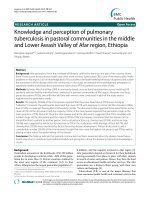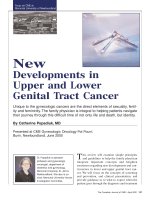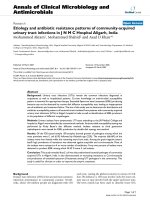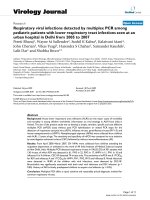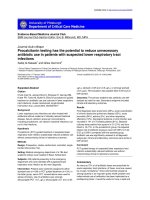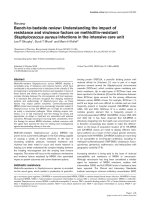actual situation of lower genital tract infections in married women aged 18-49 in the marine and island areas, hai phong city and effectiveness of some intervention solutions ttta
Bạn đang xem bản rút gọn của tài liệu. Xem và tải ngay bản đầy đủ của tài liệu tại đây (313.32 KB, 24 trang )
-1BACKGROUND
The lower genital tract infection has been one of women’s diseases which
causes a great influence on the physical as well as mental health of the sick women,
especially for ones in rural areas, including the marine and island area. Therefore,
studies on infections of the lower genital tract infections in women at the marine and
island areas have had an important role in contribution of study data to make suitable
solutions to improve people's health.
However, studies that were valuable and satisfied the above requirements are
still limited. In particular, there have been no studies in Vietnam on the current
situation and factors associated with the lower genital tract infections in women as
well as of the effective measures to improve the prevention of these diseases in the
marine and island areas. The previous studies in this field were mainly implemented
in other geographical and ecological areas.
In the above context, this study was done to help the health sector of Vietnam
get research data on the lower genital tract infections in women in the marine and
island areas in order to find appropriate solutions to improve the provision of high
quality reproductive health care services for this target group. With the study sites
which are marine and island areas of Hai Phong City where there have been no formal
studies on the lower genital tract infections in women, the study aims to give out new
and valuable findings not reported before. The results of the study will contribute to
the scientific basis for managers and planners to make more effective and appropriate
policies in order to improve the quality of reproductive health care services for
women in general, for women in marine and island in particular.
For the reasons mentioned above, this study was conducted with the following
objectives:
-2STUDY OBJECTIVES
1) Describe the actual situation and some factors related to the lower genital
tract infections in married women aged 18-49 in three districts of the marine and
island area of Hai Phong City in 2012.
2) Assess the effectiveness of some interventions in raising the awareness,
attitude and practice of the above target subjects on prevention of the lower genital
tract infections.
STRUCTURE OF THE THESIS
The thesis has 126 pages (excluding the table of contents, references and
annex), includes 4 chapters: Chapter 1: Literature review, 31 pages; Chapter 2: Study
subjects and methodology, 21 pages; Chapter 3: Study results, 35 pages; Chapter 4:
Discussion, 33 pages. The thesis has 37 tables, 14 figures, 131 reference documents:
72 in Vietnamese and 59 in English.
Chapter 1.
LITERATURE REVIEW
The lower genital tract infection (LGTI) is one of the very common diseases in
women and is the most common in women at the age of sexual activities. Some
studies found that the rate of women knowing about this disease accounted for less
than 60%; the understanding of the consequences and treatment of STDs is still weak;
the rate of subjects with correct knowledge on the majority of the disease-related
contents was below 50%. The research of Le Thi Oanh (2001) on women at
reproductive age shows that the rate of LGTIs in women in the urban of Hanoi was
41.5%; suburban of Hanoi was 59.4%; Thai Binh was 56.9%....
It was found that environmental pollution in agriculture and fishing, as well as
environmental pollution from manufacturing factories are related to the health of the
workers in general and women in particular.
-3Research in 6 regions of the Northern Vietnam shows that the rate of LGTIs
were very different by region, ranging from 41-64%, the highest in mountains of
Nghe An (64.07%); and the pathogens also varies by region: ones in the urban of
Hanoi were mainly bacteria, but ones in the suburbs of Hanoi were mainly fungi; the
mountainous areas of Nghe An has the highest rate of fungus as pathogens.
A trial intervention of Esere M. (2008) in adolescents through communication
activities in schools shows a clear reduction of the risk factors to sexually transmitted
diseases (STDs) in this group, and they were evaluated as a successful intervention.
The author launched a sex education program in secondary schools.
Kim Bao Giang (2011) did a research on improving the knowledge some kinds
of STDs at sewing factories in Binh Duong and Ho Chi Minh City; after one year of
communication interventions, the results shows that the development of the network
of peer educators selected from the factories was a reasonable strategy in
communication interventions to raise the awareness for workers of these factories.
Research done by Nguyen Minh Quang (2013) on female prostitutes in Hanoi
adopted health education as an intervention method. It communicated on STDs
prevention via many forms such as direct communication at class rooms, delivery of
communication materials, films, television, direct counseling.
Chapter 2.
SUBJECTS AND METHODS
2.1. Study subjects, sites and time
- Study subjects were women aged 18-49 years old, married, living in the marine
and island area of Hai Phong City.
- Pre-intervention survey was conducted in 3 districts of Hai Phong, including:
Thuy Nguyen District: representative for the rural and costal area; Do Son:
representative for the urban and costal area; and Cat Hai district: representative for the
island region.
-4- Intervention study was performed in 2 communes of Cat Hai district (1 for
intervention and 1 for control) among ones selected in the pre-intervention survey.
- Study period: from 1/2012 to 7/2013.
2.2. Methodology
The design is 2 consecutive and logical survey and study, including an
analytical descriptive cross-sectional survey and a community intervention study with
control group.
2.2.1. Sample size of the cross-sectional survey (Objective 1; Phase 1)
The sample size applies the following formula:
n Z 2 1α/ 2
pq
DE
2
d
Where: n: sample size for study; Z 1-α / 2 = 1.96 (95% confidence level); p = 0.57
(the proportion of LGTIs according to the study of Le Thi Oanh conducted in Thai
Binh province); d: desired deviation = 0.05; DE: design effect = 2).
With the above parameters, the required minimum number of the women to
study was 754 ones. In fact, the research team examined and interviewed 804 subjects
of 3 districts.
2.2.2. Sample sizes for the intervention study (Objective 2; Phase 2)
The formula for calculating the sample size:
n
{Z (1 / 2) p1 (1 p1 ) Z (1 ) p2 (1 p2 )}2
( p1 p2 ) 2
Where: p1: the proportion of LGTIs before intervention, which is determined
from the results of survey in the Phase 1, equal to 0.6; p2: the expected proportion of
LGTIs after intervention, equal to 0.46; Z (1-α/2): the confidence interval of 95%, equal
to 1.96; Z (1- ): the probability distribution, equal to 1.28.
-5The sample size was multiplied by the design effect of 2. Because the
calculated sample size is nearly equal to the sample size of Cat Hai district in Phase 1
(267 subjects), this study remained that sample size for Phase 2 (267 subjects).
2.2.3. Sampling method
- Cluster sampling for the cross-sectional study (Objective 1; Phase 1).
- Sampling ratio of 1:1 for selection of the case and control in the intervention
study (Objective 2; Phase 2)
2.2.4. Data collection and processing
* Interview with survey subjects: done at households to collect data on
knowledge, attitudes and practices of women on LGTIs by questionnaires; sent the
invitation letter to the subjects for doing gynecological examination.
* Do gynecological examination tests to diagnose LGTIs:
- Gynecological examination: The study subjects were examined to assess the
actual condition of LGTIs.
- Para-clinical testing: For the subjects suspected to have LGTIs through
clinical examination, physicians took swabs of the vagina and cervix for testing
according to the instructions about doing tests of the Ministry of Health.
2.2.5. Intervention solutions
- Solution 1: Combination of therapy with counseling at the survey site:
treatment with procedures and drugs. Consultation on contents related to the diseases
(right after examination and treatment) at the commune health centers.
- Solution 2: Continuous communication at community: periodic information
was provided in the intervention: communication by the communal loudspeaker
system; discussions integrated into women's meetings at villages; home visits.
- Solution 3: Monitoring and providing technical support for commune health
centers: monitoring combined with technical support for commune health center once
every month. Implementers were obstetricians of the District Health Center.
-6- Time of intervention was 12 months.
2.2.6. Some evaluation criteria
- Knowledge is considered as the "pass" level when the subjects correctly
answered at least 50% of the items of each content in the questionnaires.
- Attitude at the "pass" level if the subject shows the "necessary", "importance"
of related contents affecting health.
- A poor household is determined according to the "Standard of poor and nearpoor households in the period 2011-2015" of the Government. Accordingly, a poor
household in rural areas is one having an average income of not over than 400,000
VND / person / month.
2.2.7. Data processing
The statistical parameters and calculations in the study include: The number,
percentage; Comparison of 2 rates by Chi-square test; Identification of p-value for
tests done; Calculation of Odds ratio with 95% confidence interval (CI95%);
Calculation of intervention effect to evaluate the actual effectiveness of interventions.
Chapter 3.
STUDY RESULTS
3.1. Actual situation, factors related to the lower genital tract infections
Table 3.1. Prevalence rate of lower genital tract infections
Examination results
Number
Percentage
Disease
489
60.8
No diseases
315
39.2
804
100.0
Total
Among 804 women who received gynecological exams, 489 ones had LGTIs; this
number equivalent to the prevalence rate of LGTIs of 60.8%.
-73,1
Vulvanosis - vaginosis - cervicitis
7,7
Vaginosis - cervicitis
Vulvanosis-vaginosis
2,6
Single cervicitis
14,3
Single vaginosis
23
Single vulvanosis
10,1
0
5
10
15
20
25
Figure 3.1. Rate of LGTIs in all the women examined, by location and combination
mode of infection (n = 804)
The number of women with single vaginosis accounted for the highest rate
(23%), followed by women with single cervicitis (14.3%) and single vulvanosis
(10.1%). Very low rates of women were found having the cervicitis-vaginosis,
vulvanosis - vaginosis - cervicitis (2.6 and 3.1%, respectively).
Table 3.2. Distribution of diseases in all the women with LGTIs
Diseases
Number of cases
Percentage
Single vulvanosis
81
16.5
Single vaginosis
185
37.9
Single cervicitis
115
23.6
Vulvanosis-vaginosis
21
4.2
Vaginosis - cervicitis
62
12.6
Vulvanosis - vaginosis - cervicitis
25
5.2
489
100.0
Total
-8Among 489 women diagnosed with LGTIs, the highest rate among 6 groups of
LGTIs was the single vaginosis (37.9%), followed by single cervicitis (23.6%). In the
remaining ones, the rate of women having the diseases ranged from 5.2% to 16.5%.
Table 3.3. Distribution of causes of disease in all the women with LGTIs
Cause
Number of cases
Percentage
Candida
153
31.3
Trichomonas
35
7.2
General bacteria
143
29.2
Chlamydia
97
19.8
Gonorrhea
0
0
Other
61
12.5
489
100.0
Total
The most common cause of LGTIs was Candida (31.3%), followed by general
bacteria (29.2%), Chlamydia (19.8%). No cases of gonorrhea were found among the
surveyed women.
3.1.3. Some factors related to the lower genital tract infections
Table 3.4. Relation between the age of women and LGTIs
Age group
LGTIs
Surveyed
OR
p
women
Case
%
CI95%
18-29
149
97
65.1
1.3
30-49
655
392
59.8
(0.85 to
804
489
60.8
1.85)
Total
> 0.05
-9There was no statistically significant difference of the rates of women having
LGTIs between two age groups 18-29 and 30-49; p> 0.05.
Table 3.5. Relation between the education of women and LGTIs
Education Level
LGTIs
Surveyed
OR
p
women
Case
%
CI95%
Primary school or lower
650
407
62.6
1.5
Secondary school or higher
154
82
53.2
(1.02 to
Total
804
489
60.8
2.13)
<0.05
The women who completed primary school or lower had the LGTI rate (62.6%)
higher than that of women of secondary school or higher (53.2%).
Table 3.6. Relation between the occupation of women and LGTIs
Occupation
LGTIs
Surveyed
OR
p
and fishing
Other
Case
%
CI95%
286
189
66.1
1.4
518
Aquaculture, processing
women
300
57.9
(1.0 5 to
<0.05
1.91)
Total
804
489
60.8
The women with occupation of aquaculture, processing and fishing had the
LGTI rate (72.2%) higher than that of the other women (59.6%).
-10Table 3.7. Relation between the economic condition of women and LGTIs
LGTIs
OR
Household economic
Surveyed
condition
women
Case
%
72
52
72.2
Poor
p
CI95%
1.7
Average and wealthier
730
437
59.9
<0.05
(1.01 - 2.98)
Total
804
489
60.8
The women living in poor households have the LGTI rate (72.2%) higher than
that of those living in wealthier or average households (59.9%), p <0.05.
Table 3.8. Relation between having private bathrooms and LGTIs
Bathroom
Not having bathrooms
LGTIs
Surveyed
OR
p
women
Case
%
363
237
65.3
CI95%
1.4
Having bathrooms
441
252
57.1
<0.05
(1.05 to 1.90)
Total
804
489
60.8
The women living in households without private bathrooms had the LGTI rate
(65.3%) higher than women living in households with private bathroom (57.1%).
Table 3.9. Relation between the abortion history and LGTIs
History of Abortion
Surveyed
LGTIs
OR
p
women
Case
%
With abortion
420
294
70.0
Without abortion
384
195
50.8
804
489
60.8
CI95%
2, 3
<0.05
(1.68 to 3.05)
Total
-11Women who had abortion had the rate of LGTIs (70%) higher than women who
have never experienced abortion (50.8%) (OR=2.3, CI: 1.68 to 3.05, p <0.05).
Table 3.10. Relation between the number of abortions and LGTIs
Number of abortions
LGTI
Surveyed
OR
p
women
Case
%
CI95%
3 times or more
79
65
82.3
2.3
1-2 times
341
229
67.2
(1.08 to
420
294
70.0
4.44)
Total
<0.05
Among women who have had abortions, those having had 3 or more times of
abortion had a higher risk of LGTIs than those having 1-2 times of abortion (82.3%
vs. 67.2%).
Table 3.11. Relation between receiving mobile gynecological examination in the
previous year and LGTIs
LGTIs
OR
Mobile gynecological
Surveyed
examination
women
Case
%
CI95%
612
391
63.9
1.7
Examined
Not examined
Total
p
192
98
51.0
(1.21 to
804
489
60.8
<0.05
2.39)
The rate of women not having gynecological examination to prevent or treat the
diseases have the rate of the diseases (63.9%) higher than that of the women who had
ever had gynecological examination (51%).
-12Table 3.12. Relation between using intrauterine devices and LGTIs
Using status
Currently using
LGTI
OR
Surveyed
women
Case
%
252
156
61.9
CI95%
p
0, 98
Not currently using
552
333
60.3
> 0.05
(0.7 7 -1, 24)
Total
804
489
60.8
There was no relation between the use of intrauterine devices for contraception
of the women with the rate of LGTIs (OR = 0.98).
3.2. Effectiveness of some intervention solutions
Table 3.13. Change in the rate of women knowing the causes of disease
Intervention group
Measurable unit
Control group
(n = 267)
(n = 267)
Change
After
Before
After
(1)
Number of cases
Before
(2)
(3)
(4)
202
237
198
(%)
194
19.3
Percentage
Comparison
75.7
88.8
74.2
72.6
p (1&2) <0.05; p (3&4)> 0.05
The rate of women in the intervention group knowing the causes of LGTIs after
intervention (88.8%) was higher than that before the intervention (75.5%). The
difference is statistically significant, p<0.05.
-13Table 3.14. Change in the rate of women knowing the symptoms of LGTIs
Intervention group
Measurable unit
Control group
(n = 267)
(n = 267)
Change
After
Before
(2)
(3)
(4)
159
220
164
(%)
After
(1)
Number of cases
Before
168
35.8
Percentage
59.6
82.4
Comparison
61.4
62.9
p (1&2) <0.05; p (3&4)> 0.05
The rate of women in the intervention group knowing the symptoms of LGTIs
after intervention (82.4%) increased when compared to the pre-intervention (59.6%),
p <0.05.
Table 3.15. Change in the rate of women knowing transmission route
Intervention group
Measurable unit
Control group
(n = 267)
(n = 267)
Change
After
Before
After
(1)
Number of cases
Before
(2)
(3)
(4)
151
215
146
(%)
138
48.0
Percentage
Comparison
56.5
80.5
54.7
51.7
p (1&2) <0.05; p (3&4)> 0.05
The rate of women in the intervention groups knowing routes of disease
transmission after intervention (80.5%) increased when compared to the preintervention (56.5%), p <0.05; while that of the control tends to decrease (from 54.7%
to 51.7%).
-14Table 3.16. Change in the rate of women knowing the consequences of LGTIs
Intervention group
Measurable unit
Control group
(n = 267)
(n = 267)
Change
After
Before
After
(1)
Number of cases
Before
(2)
(3)
(4)
181
224
159
(%)
172
15.7
Percentage
67.8
83.9
Comparison
59.6
64.4
p (1&2) <0.05; p (3&4)> 0.05
The rate of women in the intervention group knowing the consequences of the
disease after intervention (83.9%) was higher than before intervention (67.8%),
p<0.05, significantly increased when compared to the control (from 59.6% to 64.4%).
Table 3.17. Change in the rate of women knowing sources of information on LGTIs
prevention
Intervention group
Measurable unit
Control group
(n = 267)
(n = 267)
Change
After
Before
After
(1)
Number of cases
Before
(2)
(3)
(4)
155
198
168
(%)
151
37.9
Percentage
Comparison
58.1
74.2
62.9
56.5
p (1&2) <0.05; p (3&4)> 0.05
The rate of the intervened women knowing sources of information on prevention
of LGTIs increased after intervention when compared to the pre-intervention (74.2%
vs. 58.1%) while the rate in the control decreased (from 62.9% to 56.5%). The
difference of before-after intervention was statistically significant, p <0.05.
-15-
% 100
95,1
82
Effect = 18,3%
77,5
75,7
80
60
p<0,05
Before
intervention
After
intervention
p>0,05
40
20
0
Intervention
Control
Figure 3.2. Change in the rate of women knowing how to ensure the external
genital hygiene (n=267)
The rate of intervened women knowing how to ensure external genital hygiene
was higher than the control (95.1% vs. 82%), p<0.05; Intervention effect is 18.3%.
Table 3.18. Change in the rate of women knowing how to ensure the intercourse
and menstrual hygiene
Knowing how to properly
toilet
SL
Intervention group
(n = 267)
Before
After
(1)
(2)
211
250
Control group
(n = 267)
Before
After
(3)
(4)
215
211
Intercourse hygiene
20.3
%
79
93.6
80.5
79
SL
215
245
207
211
Menstrual hygiene
12.1
%
Comparison
Change
(%)
80.5
91.8
77.5
79
p (1&2) <0.05; p (3&4)> 0.05
The rate of the intervened women knowing ways to ensure the intercourse
hygiene increased after intervention when compared to the pre-intervention (93.6%
-16vs. 79%). It is similar to how to ensure menstrual hygiene; the difference between
before and after intervention was statistically significant, p<0.05.
Table 3.19. Change in the rate of women having right attitudes to LGTIs
Measurable unit
Number of cases
Intervention group
(n = 267)
Before
After
(1)
(2)
181
211
Control group
(n = 267)
Before
After
(3)
(4)
164
155
Change
(%)
21.9
Percentage
67.8
Comparison
79
61.4
58.1
p (1&2) <0.05; p (3&4)> 0.05
The rate of women in the intervention group having right attitudes when
choosing places for initial health care of LGTIs which are medical facilities after
intervention increased when compared to the pre-intervention (79% vs. 67.8%). The
difference before and after interventions was statistically significant, p<0.05.
3.2.3. Changes in the lower genital tract infections after intervention
Table 3.20. Changes in the rate of LGTIs in women
Measurable unit
Number of cases
Intervention group
(n = 267)
Before
After
(1)
(2)
162
82
Control group
(n = 267)
Before
After
(3)
(4)
16 3
158
Change
(%)
46.2
Percentage
Comparison
60.7
30.7
61.1
59.1
p (1&2) <0.05; p (3&4)> 0.05
The rate of women having the overall LGTIs fell after intervention when
compared to the pre-intervention (30.7% vs. 60.7%), p <0.05. While this rate in the
control group did not changed much (6 1, 1% vs. 59.1%).
-17-
% 16
p<0,05
p>0,05
10,9
11,2
10,1
12
8
Before
interventio
n
After
interventio
n
5,2
4
0
Intervention
Control
Figure 3.3. Changes in the rate of single vulvanosis (n = 267)
The rate of women with single vulvanosis after intervention decreased when
compared to the pre-intervention (5.2% vs. 10.1%), with p<0.05. While the
corresponding one in the control group almost unchanged (10.9% vs. 11.2%) at 2
points of time - before and after intervention.
Table 3.21. Changes in the rate of single vaginosis
Intervention group
Measurable unit
Control group
(n = 267)
(n = 267)
Percentage
Comparison
After
Before
After
(1)
Number of cases
Before
(2)
(3)
(4)
61
38
60
58
22.9
14.2
22.5
21.7
p (1&2) <0.05; p (3&4)> 0.05
The rate of women having single vaginosis fell after intervention (reduced
from 22.9% to 14.2%), the difference was statistically significant, p<0.05. This rate
in the control group did not change significantly (22.5% vs. 21.7%).
-18-
% 20
13,9
14,2
16
12
13,1
Before
interventio
n
After
interventio
n
7,9
8
4
p<0,05
p>0,05
0
Intervention
Control
Figure 3.4. Change in the rate of single cervicitis (n = 267)
In the intervention group, the rate of women diagnosed with single cervicitis
after intervention reduced when compared to pre-intervention (14.2% to 7.9%), the
difference was statistically significant, p <0.05.
Table 3.22. Change in rate of vulvanosis - vaginosis - cervicitis (n=267)
Measurable unit
Number of cases
Percentage
Comparison
Intervention group
(n = 267)
Before
After
(1)
(2)
36
9
13.5
3.4
Control group
(n = 267)
Before
After
(3)
(4)
36
35
13.5
13.1
p (1&2) <0.05; p (3&4)> 0.05
In the control group, the rate of women having vulvanosis - vaginosis cervicitis after intervention reduced significantly when compared to pre-intervention
(13.1% reduced to 3, 4%), the difference was statistically significant, p <0.05.
-19Chapter 4.
DISCUSSION
4.1. Actual situation and some factors related to the lower genital tract infections
Among 804 married women aged 18-49 in this study, 489 ones had LGTIs,
equivalent to the rate of 60.8%. Comparing this rate in my study with the results of
the study of Vu Ba Hoe on women in reproductive age in Vinh Bao District, Hai
Phong (2008) whose rate was 62.9%, the rate in my study was slightly lower. Similar
findings were identified when comparing the results of this study with ones of the
study of Bui Thi Thu Ha (2007) in which the corresponding rate was 62.1%.
However, when compared with the findings of some domestic and foreign authors,
the LGTI rate in my study is slightly higher. Particularly, the research of Le Thi Oanh
(2001) done in Thai Binh shows an LGTI rate was 56.9%, and the corresponding rate
in the survey of Zhang XJ (2009) conducted in China was 58.1%.
For the disease pattern in my study, the highest rate in 6 group of LGTIs was
single vaginosis (37.9%), followed by single cervicitis (23.6%). The rates in the
reducing order in this study is consistent with findings in the studies of Do Thi Uyen
conducted in Hai Phong (2012); accordingly, the highest rate was found for
vaginosis (45,7%), followed by cervicitis (26,3%); however, the rate of the two
leading diseases in my study was a little lower than the corresponding one in that
survey.
The structure of the causes of disease in my study has some difference with
some other studies. Compared with the results of the research conducted by Do Thi
Uyen in An Lao, Hai Phong in 2012, the structure of the causes of disease was
different, for instance: Candida (31.2% vs. 17.2%). In the research done by Ngo Duc
Tiep in Le Chan District, Hai Phong City (2011), Candida was 18.3%.
-20Results of my study show that there is an association between the economic
status of women with LGTIs. This finding is consistent with the report of the
Program for Application of Medical Techniques in the United States. According to
my study, women who have ever experienced abortion had a higher rate of LGTIs
(70%). The number of women having abortion at least 3 times had higher risk of
LGTIs than those who experienced only 1-2 times of abortion (82.3% vs. 67.2%). The
reason may be that after several times of abortion, in addition to a poorer health, the
general resistance of women also reduced which made their cervix easily to be
vulnerable during applying abortion procedure.
In my study, women who have never been consulted about how to prevent the
disease had the LGTI rate (79.8%) higher than women who were advised about it
(43.6%); p<0.05. Maybe that in a long time, we were only interested in reducing
fertility through the family planning program, not paid adequate attention to other
issues of reproductive health, including STIs, LGTIs in women.
4.2. Effectiveness of some intervention methods
The rate of women in the intervention group knowing the causes of LGTI after
intervention (88.8%) increased when compared to pre-intervention (77.5%). In
addition, the rate of women in the intervention group knowing symptoms of LGTIs
after intervention also significantly increased when compared to pre-intervention and
markedly higher than the corresponding increase in the control group. Knowing the
symptoms of the disease will help women detect the disease early, diagnose and treat
promptly and effectively for prevention of LGTIs.
Disease prevention is one of the communication contents concerned the most.
Knowing the disease prevention, women will have the right attitude and behavior to
avoid contact with the exposed elements, as well as correctly identify those who
should be treated when having the disease. This is one of the most important factors
in contributing to achieving the ultimate goal to reduce LGTIs in the community in
-21general, among the intervened women in particular. Intervention results show the rate
of women in the intervention group knowing how to prevent LGTIs after intervention
increased when compared to pre-intervention (75.7% vs. 53.2%) while the
corresponding rate in the control decreased (from 48.3% to 46.8%). The difference
before-after intervention was statistically significant and the intervention effect is
relatively high.
Going for periodic gynecological examination of women is recommended to
help them to have timely detection, treatment with high efficiency to avoid
unfortunate complications which may occur; it also prevents the spread of the
disease in the community, especially in high-risk subjects. Women are
recommended to have gynecological examination at least 2 times each year, even if
they are not suspected of having disease manifestations. The rate of women in the
intervention group knowing the need of at least 2 gynecological examinations every
year after the intervention increased when compared to the pre-intervention (80.5%
vs. 69.3%), p <0.05; intervention effect was 27.6%.
Genital hygiene is a very important issue, especially in prevention of genital
tract infection in general, LGTIs in particular. Through the communication solutions
done in my study, the percentage of women in the intervention group knowing the
needed number of times for genital hygiene every day after intervention increased
when compared to pre-intervention (93.6% vs. 80.5%), whereas the rate in the control
group decreased (from 79% to 77.5%). In addition, the rate of women in the
intervention group knowing how to ensure intercourse hygiene after intervention was
higher than before the intervention (93.6% vs. 79%). Women who are poor in daily
genital hygiene, menstrual hygiene, intercourse ensure hygiene, and water hygiene
(water and bathroom) have higher risks of LGTIs.
Corresponding to the increase in the rate of women knowing the need of at
least 2 gynecological examinations every year, after intervention, the rate of women
-22in the intervention group who applied gynecological examinations at least 2 times in
the previous year also increased when compared to the pre-intervention (44.2% vs.
38.9%). Results of my study are consistent with findings of Aggarwal AK (2004)
which adopted a model of intervention in rural India with health education in health
facilities combined with household visits to improve the people’s utilization of services;
after the intervention, the clients’ use of services of reproductive health care at local
health facilities was improved significantly.
LGTIs are an important problem for women's health because it affects the
health, working ability, life and sexual activity, not only of the women but also of
their husbands. Sometimes these diseases cause severe complications if women are
not diagnosed and treated promptly and thoroughly. Some complications are uterus,
ovarian infections, cervical cancer... Therefore, reducing LGTIs is one of the expected
intervention results in this study. The findings of my study show that the rate of
LGTIs after intervention reduced significantly when compared to the pre-intervention
(30.7% vs. 60.7%), p<0.05.
According to the study results, the percentage of women having combination
infection of the vulva, vagina, cervix after intervention reduced when compared to the
pre-intervention (13.1% reduced to 3.4%), p <0.05. For infections of vagina-cervix or
vulva-vagina-cervix, they are not dangerous to the patient's life, but make very
negative impact on the quality of daily life of women, such as itching, discomfort
moisture, odor causing confidence loss, sex life, and reproductive health. The danger
of these diseases is that they can accelerate the development of cervicitis as this is a
preferred location for some types of bacteria to attack, such as Trichomoniasis,
fungus, general bacteria, or agents transmitted sexually, for example Chlamydia,
gonorrhea bacteria, herpes.... These agents are main causes of single cervicitis or
combined with infection of vulva, vagina to upstream to cause fallopian tube
infection, endometrial infection, pelvic infection.... which easily results in infertility.
-23Vietnam has a scheme for Health development of the marine and island areas
till 2020 with many health priorities. This study shows that the LGTI pattern of the
women of the marine and island areas has its own characteristics. These issues need
specific solutions to solve. These findings also demonstrate that new policies which
were issued in relation to health care for people of the marine and island areas of the
Party and the State have been meeting the needs of the actuality.
CONCLUSIONS
1. Actual situation and some factors related to the lower genital tract infections
in married women aged 18-49 in three districts of the marine and island area of
Hai Phong City in 2012:
- The rate of lower genital tract infections in the studied women was 60.8%; the
most common one was single vaginosis (37.9%), followed by single cervicitis
(23.6%).
- The structure of the causes of the lower genital tract infections: the most
common is Candida (31.3%), followed by general bacteria (29.2%).
- Women with low education, in poor households, without clean water, having
no private bathroom are at higher risk for lower genital tract infections (p<0.05).
- Women working in aquaculture, processing and fishing have a higher rate of
lower genital tract infections than the remaining ones (66.1% vs. 57.9%, p <0, 05).
- Women who have had no periodical gynecological exams, ever had abortion,
many times of abortion, never been consulted about prevention of LGTIs are at higher
risk for lower genital tract infections than the others (p<0.05).
2. Effectiveness of some interventions in raising the awareness, attitude and
practice of women on prevention of the lower genital tract infections:
- The rate of women in the intervention group knowing the causes, symptoms,
transmission route, consequences and prevention of the diseases; knowing the sources
-24of information, appropriate treatment addresses and genital hygiene, after intervention
increased when compared with pre-intervention (p<0.05).
- The rate of women in the intervention group having right attitude to the lower
genital tract infections after intervention was higher than before intervention (77.5%
vs. 64.4%, p<0, 05).
- The rate of women in the intervention group who experienced at least 2 times
of gynecological examination in a year after intervention increased when compared to
the pre-intervention (p <0.05).
- The rate of women having lower genital tract infections after intervention
decreased much when compared to the pre-intervention (30.7% vs. 60.7%); p <0.05.
- The rate of women having vulvanosis - vaginosis - cervicitis after intervention
reduced much when compared to pre-intervention (13.1% reduced to 3.4%); p <0.05.
RECOMMENDATIONS
1. Women in the marine and island areas have the rate of lower genital tract
infections rather higher than some other ecological regions; therefore, it is needed to
have policies to improve the quality of health care in general, control of lower genital
tract infections for women in particular, in the marine and island areas.
2. Women working in aquaculture, processing and fishing are at higher risks
for lower genital tract infections when compared with the others; therefore, in the
marine and island areas, more priorities should be given to these subjects when
applying supportive policies.
3. The combination of onsite treatment and consulting, health education and
communication integrated into community activities, technical support for commune
health centers show a high effect when applied to the marine and island areas.
Therefore, ones may review and expand this model to other similar localities.

